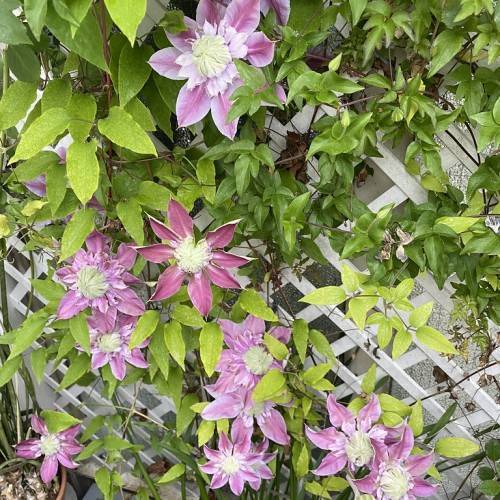
clematis
Clematis 'Evijohill' JOSEPHINE
Cycle:
Perennial
Watering:
Average
Hardiness Zone:
4 - 9
Flowers:
Flowers
Sun:
Full sun,part shade
Leaf:
Yes
Growth Rate:
High
Maintenance:
Moderate
Salt Tolerant:
Yes
Care Level:
Medium
watering
Clematis 'Evijohill' JOSEPHINE is a type of clematis plant that requires consistent and deep watering. The amount of water needed will depend on the weather conditions and the environment. Generally, you should water the plant deeply when the soil feels dry to the touch. You can check the soil moisture levels at the root level by pushing your finger into the soil to the depth of your first knuckle. If the soil feels dry, it's time to water. Water the clematis deeply to help ensure that the moisture penetrates deep into the ground, saturating the roots thoroughly. Clematis should be watered at least once per week during warmer months and every other week during cooler months.
sunlight
Clematis 'Evijohill' Josephine grows best in full sun to partially shaded areas. In its ideal growing environment- where the plant receives at least 5-6 hours of direct sunlight per day-it will produce beautiful blooms. In areas with extreme heat or strong winds, a partially shaded spot will help to prevent the plant from enduring damaging elements. It can also grow in regions with intense cold, but should be sheltered with additional insulating material. Having too much shade or sun exposure can reduce flowering and cause the plant to be stunted. For this reason, it's best to avoid exposing the plant to extreme lighting situations.
pruning
Pruning a clematis of the species 'Evijohill' (Clematis 'Evijohill' JOSEPHINE) should be done twice a year, typically in early spring and late summer. In the early spring, prune the clematis after it has finished flowering, cutting it back to just above the lowest pair of strong buds. This encourages better flowering in the summer. In the late summer, deadhead the remaining flowers on the plant and prune away any dead or overgrown shoots. If you want the clematis to stay bushier, prune lightly following the late summer trim.
Season
Hardiness Map
FAQ
Can Clematis plants grow in pots?
Yes, Clematis plants can definitely be grown in pots. When planting a Clematis in a pot make sure to use a larger size pot with drainage holes and fill it with a mix of well-draining potting soil and compost. Ensure to keep the root area cool and the pot in a sunny location while providing regular water and fertilization. Check the plant almost daily to make sure it is not becoming too dry. Clematis can do well in a pot and with the right care and conditions, they will thrive.
Are Clematis plants self-pollinating?
No, clematis plants are not self-pollinating. Clematis plants need pollinators such as bees, butterflies, moths and other insects to transfer pollen from the male anthers to the female stigma of the flower in order to produce viable seed. Pollination must also occur within relatively close proximity of the same species in order to create viable hybrid plants.
Can Clematis plants be grown as a houseplant?
Yes, Clematis plants can be grown as a houseplant. It is best to grow them in a pot with full sun and a soil that is rich in organic material and retains moisture. When potting the plant, place a stake or trellis next to the pot so that the vine can climb when it begins to grow. Be sure to water your Clematis plant regularly to keep it healthy and growing. Additionally, keep an eye out for pests and treat with natural insecticides as necessary.
Could Clematis plants survive in a colder climate?
Yes, Clematis plants can survive in colder climates with proper preparation. If planted in the fall, proper mulching should be done to protect the roots from cold temperatures. If planted in the spring, they should be watered frequently to help them adjust to the cooler temperatures more quickly. If temperatures drop below -20°C ( -4°F), additional measures may need to be taken such as the application of protective wraps and thermal insulation. Additionally, plants in exposed areas should be protected from the wind to prevent excessive dehydration. With the right measures in place, Clematis plants can easily survive in colder climates.
Could Clematis plants be grown in a greenhouse?
Yes, clematis plants can be grown in a greenhouse. Due to their vine-like growth habit and tropical native origins, clematis plants thrive in the moist and warm environment of a greenhouse. Clematis are generally grown from cuttings or from dividing existing plants, and benefit from regular pruning and fertilizing. They will also enjoy the indirect light of a greenhouse and the protection from strong winds and temperatures that the humidity and contained environment provides.
